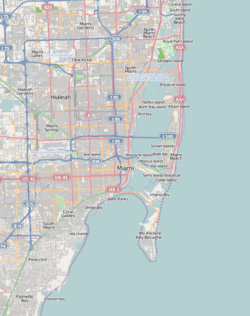St. Bernard de Clairvaux Church facts for kids
Quick facts for kids |
|
|
Old Spanish Monastery
|
|

Central courtyard surrounded by the cloisters
|
|
| Location | North Miami Beach, Florida, United States |
|---|---|
| Built | 1133–1141 |
| Architectural style | Romanesque |
| NRHP reference No. | 72000307 |
| Added to NRHP | November 9, 1972 |
The St. Bernard de Clairvaux Church is a very old Spanish monastery building. It was first built in Spain in the 1100s. Imagine, it was taken apart, shipped across the ocean, and then put back together in Florida! Today, it is an Episcopal church and a popular place for visitors. People also call it the Ancient Spanish Monastery.
Contents
A Monastery's Early Life in Spain
This special building was a Cistercian monastery. Monasteries are places where monks live and pray. It was built between 1133 and 1141. At first, it had a different name, but it was later named after a saint called Bernard of Clairvaux. For almost 700 years, monks lived and worked there.
However, in the 1830s, during a time of big changes in Spain, the monastery was taken over by the government. It was then used as a place to store grain and as a stable for animals.
Where the Monastery Began
The monastery was located in a mountain area in Spain, near a place called Sacramenia. This region is known for its old churches, chapels, and castles. The monastery was built strong, like a fortress, because there were often conflicts in the area.
King Alfonso VII of Castile and León started the monastery. He brought Cistercian monks from France to live there. The kings gave the monastery special rights. For example, they didn't have to pay taxes for people or goods traveling through their land.
Changes in the Region
During those times, there were many changes in Spain as Christians took back land from Muslims. New monasteries like this one helped to spread Christianity. The area around the monastery had good farming land with irrigation systems built by Muslims.
Sometimes, the new monks and the people already living in the area had disagreements. These were about things like trade routes, salt production, and water use.
In 1641, parts of the monastery had to be rebuilt after a fire. The monastery stayed active until 1835. Then, it was closed down by the government, and the main church became private property.
The Monastery's Big Move to America
Most of the historic monastery building is now in the United States. This includes the cloister (a covered walkway around a courtyard), the chapter house (where monks met), and the refectory (the dining hall). The rest of the original monastery, like the church, is still in Spain.
How It Came to the USA
In 1926, a very wealthy American named William Randolph Hearst bought the monastery's cloister and other parts. He bought them even though the Spanish government had rules against it. To move it, the building was carefully taken apart. Each stone was numbered and packed into wooden crates. There were 11,000 crates in total!
But there was a problem. When the crates arrived in the USA, they were held back because of an animal disease outbreak in Spain. The hay used for packing was burned to stop the disease from spreading. When the monastery parts were repacked, some of the labels got mixed up. This made it very hard to put the building back together.
William Randolph Hearst couldn't rebuild the monastery himself because he ran into money problems. So, the dismantled buildings stayed in a warehouse in New York for many years.
Rebuilding in Florida
In 1952, two men named Raymond Moss and William Edgemon bought the monastery parts. They decided to rebuild it in northern Miami, Florida. It took them 19 months and cost almost 1.5 million dollars to put the ancient building back together. Some of the original stones were not even used.
They also added other old Spanish decorations to the monastery. For example, a large carved stone coat of arms (a symbol of a family) was added to the cloister. This coat of arms came from another Spanish monastery. Once rebuilt, the monastery became a popular place for tourists.
The Monastery Today
In 1964, the Episcopal Church bought the monastery. It was later sold to Colonel Robert Pentland Jr., who then gave it to the local Episcopal church, St. Bernard de Clairvaux. Today, it serves as an active church and a beautiful historical site. People visit it for its history, architecture, and peaceful gardens. It's also a popular place for weddings and other events.
Gallery
See also
 In Spanish: Monasterio Español de Sacramenia (Miami) para niños
In Spanish: Monasterio Español de Sacramenia (Miami) para niños








